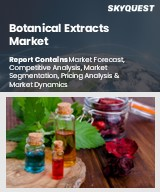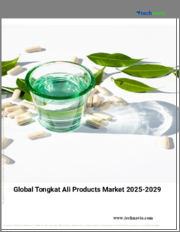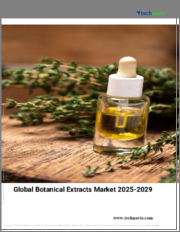
|
시장보고서
상품코드
1758718
식물 추출물 시장 규모, 점유율, 성장 분석 : 공급원 유형별, 형태별, 추출 기술별, 용도별, 지역별 산업 예측(2025-2032년)Botanical Extracts Market Size, Share, and Growth Analysis, By Source Type (Spices, Herbs), By Form (Powder, Liquid), By Extraction Technology, By Application, By Region - Industry Forecast 2025-2032 |
||||||
세계의 식물 추출물 시장 규모는 2023년에 63억 달러로 평가되었고, 2024년 67억 9,000만 달러에서 2032년에는 123억 9,000만 달러로 성장하고, 예측 기간(2025-2032년)의 CAGR은 7.8%을 나타낼 전망입니다.
식물 추출물 수요는 다양한 부문에서 천연 성분의 사용이 증가하고 있음을 배경으로 급증하는 것으로 보입니다. 차, 심황, 인삼, 엘더베리 등의 인기 성분은 소비자가 보다 건강한 선택에 매료됨에 따라 기능성 제품에 통합되어 있습니다. 마음의 고조를 반영해 이러한 추출물에 대한 수요가 대폭 늘어나고 있습니다. 덧붙여 아유르베다나 중국 전통 의료 등의 전통 의료 시스템에 대한 세계의 관심이, 시장 성장을 한층 더 촉진할 것으로 예측됩니다.
목차
서론
- 조사의 목적
- 조사 범위
- 정의
조사 방법
- 정보 조달
- 2차와 1차 데이터의 방법
- 시장 규모 예측
- 시장의 전제조건과 제한
주요 요약
- 세계의 시장 전망
- 공급과 수요 동향 분석
- 부문별 기회 분석
시장 역학과 전망
- 시장 개요
- 시장 규모
- 시장 역학
- 성장 촉진요인과 기회
- 성장 억제요인과 과제
- Porter's Five Forces 분석
주요 시장 인사이트
- 중요성공요인
- 경쟁도
- 주요 투자 기회
- 시장 생태계
- 시장의 매력 지수(2024년)
- PESTEL 분석
- 거시경제지표
- 밸류체인 분석
- 가격 분석
- 규제 상황
- 이용 사례
- 기술 분석
식물 추출물 시장 규모 : 공급원 유형별&CAGR(2025-2032년)
- 시장 개요
- 향신료
- 허브
- 꽃
- 과일
- 찻잎
- 기타
식물 추출물 시장 규모 : 형태별&CAGR(2025-2032년)
- 시장 개요
- 분말
- 액체
- 잎 추출물
식물 추출물 시장 규모 : 추출 기술별&CAGR(2025-2032년)
- 시장 개요
- 물 추출
- 침지
- 달임
- 건조
- 냉압착
- 증기 증류
- 엔플루라주
- 초임계 CO2 추출
- 저비등 용매 추출
- 기타
식물 추출물 시장 규모 : 용도별&CAGR(2025-2032년)
- 시장 개요
- 식음료
- 의약품 및 영양보조식품
- 화장품 및 퍼스널케어
- 아로마테라피
- 동물 사료
- 기타
식물 추출물 시장 규모&CAGR(2025-2032년)
- 북미
- 미국
- 캐나다
- 유럽
- 독일
- 스페인
- 프랑스
- 영국
- 이탈리아
- 기타 유럽
- 아시아태평양
- 중국
- 인도
- 일본
- 한국
- 기타 아시아태평양
- 라틴아메리카
- 브라질
- 기타 라틴아메리카
- 중동 및 아프리카
- GCC 국가
- 남아프리카
- 기타 중동 및 아프리카
경쟁 정보
- 상위 5개사 비교
- 주요 기업의 시장 포지셔닝(2024년)
- 주요 시장 기업이 채용한 전략
- 최근 시장 동향
- 기업의 시장 점유율 분석(2024년)
- 주요 기업의 기업 프로파일
- 기업의 상세
- 제품 포트폴리오 분석
- 기업의 부문별 점유율 분석
- 수익의 전년대비 비교(2022-2024년)
주요 기업 프로파일
- Symrise AG(독일)
- Synthite Industries Ltd.(인도)
- Arjuna Natural Extracts Ltd.(인도)
- Naturex(프랑스)
- Kalsec Inc.(미국)
- Synergy Flavors Inc.(미국)
- Prinova Group LLC(미국)
- PT. Indesso Aroma(인도네시아)
- Haldin Pacific Semesta(인도네시아)
- Blue California(미국)
- Ransom Naturals Ltd.(영국)
- Martin Bauer Group(독일)
- International Flavors & Fragrances Inc.(미국)
- Dohler GmbH(독일)
- Givaudan SA(스위스)
- Sensient Technologies Corporation(미국)
- Botanica(캐나다)
- Indena SpA(이탈리아)
- Sabinsa Corporation(미국)
- Nexira(프랑스)
결론과 권고
KTH 25.07.03Global Botanical extracts Market size was valued at USD 6.3 billion in 2023 and is poised to grow from USD 6.79 billion in 2024 to USD 12.39 billion by 2032, growing at a CAGR of 7.8% during the forecast period (2025-2032).
The demand for botanical extracts is set to surge, driven by the increasing use of natural ingredients across various sectors. In food and beverages, botanical extracts enhance flavor, aroma, and nutritional profiles, with popular ingredients such as green tea, turmeric, ginseng, and elderberry being integrated into functional products as consumers gravitate towards healthier options. The personal care industry is also experiencing significant growth in demand for these extracts, reflecting a rising interest in natural beauty products. Additionally, the global interest in traditional medicine systems, such as Ayurveda and Traditional Chinese Medicine, is expected to further propel market growth. However, challenges such as high production costs, raw material supply fluctuations, regulatory hurdles, and limited consumer awareness may inhibit sales growth through 2032 and beyond.
Top-down and bottom-up approaches were used to estimate and validate the size of the Global Botanical extracts market and to estimate the size of various other dependent submarkets. The research methodology used to estimate the market size includes the following details: The key players in the market were identified through secondary research, and their market shares in the respective regions were determined through primary and secondary research. This entire procedure includes the study of the annual and financial reports of the top market players and extensive interviews for key insights from industry leaders such as CEOs, VPs, directors, and marketing executives. All percentage shares split, and breakdowns were determined using secondary sources and verified through Primary sources. All possible parameters that affect the markets covered in this research study have been accounted for, viewed in extensive detail, verified through primary research, and analyzed to get the final quantitative and qualitative data.
Global Botanical extracts Market Segments Analysis
Global Botanical extracts Market is segmented by Source Type, Form, Extraction Technology, Application and region. Based on Source Type, the market is segmented into Spices, Herbs, Flowers, Fruits, Tea Leaves and Others. Based on Form, the market is segmented into Powder, Liquid and Leaf Extracts. Based on Extraction Technology, the market is segmented into Water Extraction, Drying, Cold Pressing, Steam Distillation, Enfleurage, Supercritical CO2 Extraction, Low-boiling Solvent Extraction and Others. Based on Application, the market is segmented into Food & Beverages, Pharmaceuticals & Nutraceuticals, Cosmetics & Personal Care, Aromatherapy, Animal Feed and Others. Based on region, the market is segmented into North America, Europe, Asia Pacific, Latin America and Middle East & Africa.
Driver of the Global Botanical extracts Market
The global market for botanical extracts is largely driven by their acclaimed health advantages, which encompass antioxidant, anti-inflammatory, antimicrobial, and immune-supportive effects. As chronic illnesses such as diabetes, heart disease, and obesity become more prevalent, consumers are increasingly turning to natural supplements for preventive health measures. This shift towards holistic wellness is further fueled by heightened awareness of the positive impact that botanical extracts can have on overall health. Consequently, the growing interest in these natural solutions is expected to significantly enhance revenue generation in the botanical extracts market in the years to come.
Restraints in the Global Botanical extracts Market
The global botanical extracts market faces significant constraints primarily due to its reliance on the steady supply and quality of raw plant materials. Factors such as seasonal fluctuations, climate change, and unsustainable agricultural methods can disrupt the supply chain, resulting in fluctuations in prices and availability. Additionally, inconsistent quality of raw materials can lead to variability in the effectiveness and safety of the extracts, potentially eroding consumer confidence and complicating efforts to standardize products. These challenges could ultimately hinder the long-term growth and penetration of the global botanical extracts market.
Market Trends of the Global Botanical extracts Market
The Global Botanical Extracts market is experiencing a notable shift towards organic and sustainable sourcing, driven by rising consumer awareness of environmental issues. Buyers are increasingly prioritizing products derived from sustainably harvested plants, prompting brands to adopt eco-friendly practices such as fair trade and transparent supply chains. In response to escalating climate change and biodiversity concerns, manufacturers are investing in regenerative agriculture and sustainable wildcrafting techniques, ensuring the long-term viability of resources. This trend not only appeals to environmentally conscious consumers but also aligns with the broader movement towards sustainability across various sectors, reshaping the competitive landscape of the botanical extracts market.
Table of Contents
Introduction
- Objectives of the Study
- Scope of the Report
- Definitions
Research Methodology
- Information Procurement
- Secondary & Primary Data Methods
- Market Size Estimation
- Market Assumptions & Limitations
Executive Summary
- Global Market Outlook
- Supply & Demand Trend Analysis
- Segmental Opportunity Analysis
Market Dynamics & Outlook
- Market Overview
- Market Size
- Market Dynamics
- Drivers & Opportunities
- Restraints & Challenges
- Porters Analysis
- Competitive rivalry
- Threat of substitute
- Bargaining power of buyers
- Threat of new entrants
- Bargaining power of suppliers
Key Market Insights
- Key Success Factors
- Degree of Competition
- Top Investment Pockets
- Market Ecosystem
- Market Attractiveness Index, 2024
- PESTEL Analysis
- Macro-Economic Indicators
- Value Chain Analysis
- Pricing Analysis
- Regulatory Landscape
- Case Studies
- Technological Analysis
Global Botanical extracts Market Size by Source Type & CAGR (2025-2032)
- Market Overview
- Spices
- Herbs
- Flowers
- Fruits
- Tea Leaves
- Others
Global Botanical extracts Market Size by Form & CAGR (2025-2032)
- Market Overview
- Powder
- Liquid
- Leaf Extracts
Global Botanical extracts Market Size by Extraction Technology & CAGR (2025-2032)
- Market Overview
- Water Extraction
- Maceration
- Decoction
- Drying
- Cold Pressing
- Steam Distillation
- Enfleurage
- Supercritical CO2 Extraction
- Low-boiling Solvent Extraction
- Others
Global Botanical extracts Market Size by Application & CAGR (2025-2032)
- Market Overview
- Food & Beverages
- Pharmaceuticals & Nutraceuticals
- Cosmetics & Personal Care
- Aromatherapy
- Animal Feed
- Others
Global Botanical extracts Market Size & CAGR (2025-2032)
- North America (Source Type, Form, Extraction Technology, Application)
- US
- Canada
- Europe (Source Type, Form, Extraction Technology, Application)
- Germany
- Spain
- France
- UK
- Italy
- Rest of Europe
- Asia Pacific (Source Type, Form, Extraction Technology, Application)
- China
- India
- Japan
- South Korea
- Rest of Asia-Pacific
- Latin America (Source Type, Form, Extraction Technology, Application)
- Brazil
- Rest of Latin America
- Middle East & Africa (Source Type, Form, Extraction Technology, Application)
- GCC Countries
- South Africa
- Rest of Middle East & Africa
Competitive Intelligence
- Top 5 Player Comparison
- Market Positioning of Key Players, 2024
- Strategies Adopted by Key Market Players
- Recent Developments in the Market
- Company Market Share Analysis, 2024
- Company Profiles of All Key Players
- Company Details
- Product Portfolio Analysis
- Company's Segmental Share Analysis
- Revenue Y-O-Y Comparison (2022-2024)
Key Company Profiles
- Symrise AG (Germany)
- Company Overview
- Business Segment Overview
- Financial Updates
- Key Developments
- Synthite Industries Ltd. (India)
- Company Overview
- Business Segment Overview
- Financial Updates
- Key Developments
- Arjuna Natural Extracts Ltd. (India)
- Company Overview
- Business Segment Overview
- Financial Updates
- Key Developments
- Naturex (France)
- Company Overview
- Business Segment Overview
- Financial Updates
- Key Developments
- Kalsec Inc. (U.S.)
- Company Overview
- Business Segment Overview
- Financial Updates
- Key Developments
- Synergy Flavors Inc. (U.S.)
- Company Overview
- Business Segment Overview
- Financial Updates
- Key Developments
- Prinova Group LLC (U.S.)
- Company Overview
- Business Segment Overview
- Financial Updates
- Key Developments
- PT. Indesso Aroma (Indonesia)
- Company Overview
- Business Segment Overview
- Financial Updates
- Key Developments
- Haldin Pacific Semesta (Indonesia)
- Company Overview
- Business Segment Overview
- Financial Updates
- Key Developments
- Blue California (U.S.)
- Company Overview
- Business Segment Overview
- Financial Updates
- Key Developments
- Ransom Naturals Ltd. (U.K.)
- Company Overview
- Business Segment Overview
- Financial Updates
- Key Developments
- Martin Bauer Group (Germany)
- Company Overview
- Business Segment Overview
- Financial Updates
- Key Developments
- International Flavors & Fragrances Inc. (U.S.)
- Company Overview
- Business Segment Overview
- Financial Updates
- Key Developments
- Dohler GmbH (Germany)
- Company Overview
- Business Segment Overview
- Financial Updates
- Key Developments
- Givaudan SA (Switzerland)
- Company Overview
- Business Segment Overview
- Financial Updates
- Key Developments
- Sensient Technologies Corporation (U.S.)
- Company Overview
- Business Segment Overview
- Financial Updates
- Key Developments
- Botanica (Canada)
- Company Overview
- Business Segment Overview
- Financial Updates
- Key Developments
- Indena S.p.A. (Italy)
- Company Overview
- Business Segment Overview
- Financial Updates
- Key Developments
- Sabinsa Corporation (U.S.)
- Company Overview
- Business Segment Overview
- Financial Updates
- Key Developments
- Nexira (France)
- Company Overview
- Business Segment Overview
- Financial Updates
- Key Developments



















